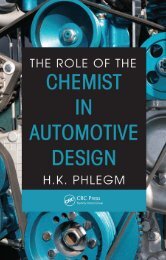Lightweight Electric/Hybrid Vehicle Design
Lightweight Electric/Hybrid Vehicle Design
Lightweight Electric/Hybrid Vehicle Design
Create successful ePaper yourself
Turn your PDF publications into a flip-book with our unique Google optimized e-Paper software.
TRAVEL ELECTRIFIED, %<br />
80<br />
70<br />
60<br />
STRATEGY OF USE<br />
MAXIMUM USE<br />
50 EV OR HV<br />
PREFERENCE<br />
40<br />
MAXIMUM USE<br />
30<br />
EV OR HV<br />
PREFERENCE<br />
(a)<br />
0<br />
0 20 30 40 50 70 100<br />
ELECTRIC RANGE, miles<br />
200<br />
EV<br />
HV<br />
HV<br />
EV<br />
PRIMARY<br />
STORAGE<br />
PRIMARY<br />
ENERGY<br />
TRANSFER<br />
DEVICE<br />
<strong>Hybrid</strong> vehicle design 145<br />
6.2.2 JUSTIFYING HYBRID DRIVE, FIG. 6.4<br />
Studies carried out at the General Research Corporation in California, where legislation on zero<br />
emission vehicles is hotly contested, have shown that the 160 km range electric car could electrify<br />
some 80% of urban travel based on the average range requirements of city households, (a). It is<br />
unlikely, however, that a driver would take trips such that the full range of electric cars could be<br />
totally used before switching to the IC engine car for the remainder of the day’s travel. This does<br />
not arise with a hybrid car whose entire electric range could be utilized before switching and it has<br />
been estimated that with similar electric range such a vehicle would cover 96% of urban travel<br />
requirements. In two or more car households, the second (and more) car could meet 100% of<br />
urban demand, if of the hybrid drive type.<br />
Because of the system complexities of hybrid-drive vehicles, computer techniques have been<br />
developed to optimize the operating strategies. Ford researchers3 , as well as studying series and<br />
parallel systems, have also examined the combined series/parallel one shown at (b). The complexity<br />
of the analysis is shown by the fact that in one system, having four clutches, there are 16 possible<br />
configurations depending on state of engagement. They also differentiated between types with<br />
and without wall-plug re-energization of the batteries between trips.<br />
6.2.3 MIXED HYBRID-DRIVE CONFIGURATIONS<br />
Coauthor Ron Hodkinson argues that while initially parallel and series hybrid-drive configurations<br />
were seen as possible contenders (parallel for small vehicles and series for larger ones) it has been<br />
found in building ‘real world’ vehicles that a mixture of the two is needed. For cars a mainly<br />
parallel layout is required with a small series element. The latter is required in case the vehicle<br />
becomes stationary for a long time in a traffic jam to make sure the traction battery always remains<br />
charged to sustain the ‘hotel loads’ (air conditioning etc.) on the vehicle’s electrical system. Cars<br />
like the Toyota Prius have 3–4 kW series capability but detail configuration of the system as a<br />
Fig. 6.4 Justifying the hybrid: (a) EV traffic<br />
potential; (b) combined series–parallel mode.<br />
PRIMARY TO<br />
SECONDARY<br />
DEVICE<br />
(b)<br />
PRIMARY CLUTCH<br />
(P)<br />
SERIES<br />
CLUTCH<br />
PRIMARY<br />
TRANSMISSION<br />
SECONDARY<br />
CLUTCH<br />
(C)<br />
(S)<br />
TIME<br />
LOSS<br />
Σ 2<br />
DRIVE<br />
CLUTCH<br />
Σ1 (D)<br />
SECONDARY<br />
TRANSMISSION<br />
SECONDARY<br />
ENERGY<br />
TRANSFER<br />
DEVICE<br />
Σ 3<br />
SECONDARY<br />
STORAGE<br />
AUX<br />
LOSS







